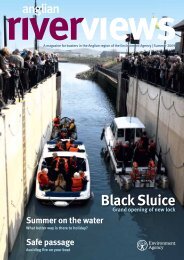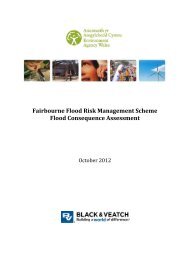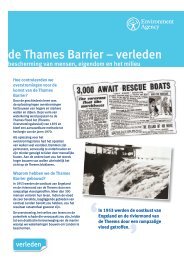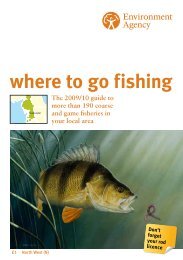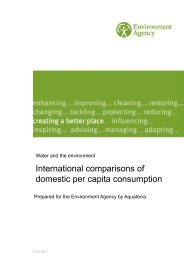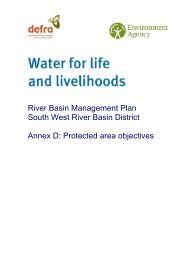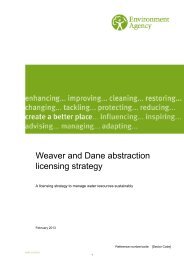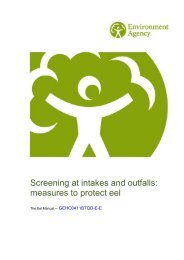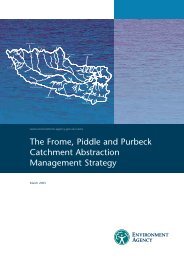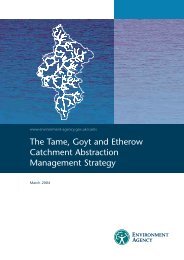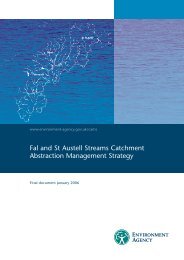Karenia mikimotoi
Karenia mikimotoi
Karenia mikimotoi
Create successful ePaper yourself
Turn your PDF publications into a flip-book with our unique Google optimized e-Paper software.
And in a public ‘information card’ produced by the State of Texas Commission for<br />
Environmental Quality - http://www.tceq.state.tx.us/files/gi-378.pdf_4146980.pdf<br />
the same information is reiterated:<br />
“P. parvum produces toxins that can affect gill-breathing organisms including<br />
fishes and freshwater molluscs. The most visible result of a fish kill caused by<br />
golden alga is dead and dying fishes of all species and sizes. Aquatic insects<br />
do not appear to be affected and may be alive during a toxic event. Large<br />
numbers of birds (including pelicans, cormorants, gulls, herons, and vultures)<br />
may be present and actively feeding on the dead and dying fishes.<br />
The Texas Department of State Health Services has stated that golden alga is not<br />
known to cause human health problems, but people should not pick up dead or dying<br />
fishes for consumption.<br />
• Mammals and birds have been observed eating dead fishes and drinking<br />
water within areas experiencing toxic golden alga blooms; no immediate<br />
harmful effects have been recorded. Complications, secondary infections or<br />
other effects may occur. Be careful of spines and bones from dead fishes<br />
on the shoreline. Puncture wounds can get infected.<br />
• Swimming near dead fishes is not recommended since bacteria levels<br />
associated with decomposition may be high.”<br />
Moustaka-Gouni et al. (2004) reported the coincidence of a Prymnesium parvum bloom<br />
and the mass kill of birds and fish in Lake Koronia, Greece, in 2004. The bird kill was<br />
later reported by the World Organization for Animal Health (OIE) to be due to avian<br />
botulism - see ftp://ftp.oie.int/SAM/2004/FAUNE_A.pdf .<br />
3.8 Fibrocapsa japonica<br />
Harmful blooms of F. japonica causing extensive kills of farmed fish have occurred in<br />
various parts of the world (Smayda, 2006 - Figure 9), mainly in temperate regions (see<br />
de Boer et al., 2005). It was originally described in Japanese waters in 1973 and was<br />
first observed in European coastal waters in 1991, including those of France and the<br />
Netherlands, and two years later in the German Bight (Smayda, 2006 and refs.<br />
therein). F. japonica has become well established in the North Sea and was reported<br />
to have reached a population maximum of 2.4 million cells.L -1 during 1997 in the<br />
German Bight (Rademaker et al., 1998).<br />
As with other raphidophytes, the specific mechanisms of toxicity remain to be<br />
elucidated. Khan et al. (1996a) isolated five neurotoxic components from a European<br />
isolate of F. japonica, designated FjTx-I, FjTx-II, FjTx-IIIa, FjTx-IIIb and FjTx-IV, which<br />
were tentatively identified as brevetoxin compounds, PbTx-1, PbTx-2, PbTx-9, PbTx-3<br />
and oxidized PbTx-2 on the basis of TLC and HPLC analysis. Brevetoxins have also<br />
been identified in an American strain of F. japonica by means of an ELISA technique<br />
(Bridgers et al., 2004).<br />
Using various sophisticated analytical techniques, including LC-MS, GC-MS and NMR,<br />
Fu et al., (2004) elucidated the molecular structures of the three main haemolytic<br />
compounds (Fj1, Fj2 and Fj3) isolated from a European strain of F. japonica. They<br />
were identified as polyunsaturated fatty acids (PUFA): 6,9,12,15-octadecatetraenoic<br />
acid (C18:4n-3, OTA), 5,8,11,14,17-eicosapentaenoic acid (C20:5n-3, EPA) and<br />
5,8,11,14-eicosatetraenoic acid (C20:4n-6 = arachidonic acid, AA). Pure commercial<br />
samples of EPA and AA were found to show the same spectroscopic and<br />
chromatographic characteristics as Fj2 and Fj3 and had a similar strong haemolytic<br />
effect. It was postulated that, when F. japonica cells accumulate in fish gills during<br />
blooms, these PUFA could be the cause of ichthyotoxicity.<br />
22 A Literature review of the potential health effects of marine microalgae and macroalgae



